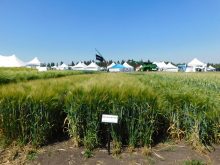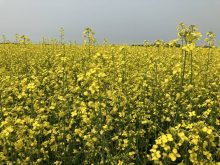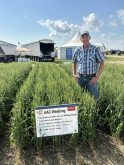Some call it northern vigour. Others call it the northern advantage.
And now, one group of Alberta researchers are setting out to prove what some farmers have been saying all along — that crops really do grow better up north.
“In this part of Alberta, we have 19 hours of daily sunlight in the summer, and a long growing season like that helps with crop development and growth,” said Samuel Peprah, manager and research co-ordinator of the Mackenzie Applied Research Association.
“This northern advantage can’t be found in the south.”
Read Also

U.S. wheat growers worried about industry moving north
U.S. wheat producers are concerned that American wheat production may begin to migrate north of the border.
And the groups funding this research are hoping to capitalize on that advantage, by positioning northern Alberta as the best location in the province for value-added processing and business investment.
“Most of the crops that we grow in Mackenzie County are basically transported south for processing, but the crops that we grow in Mackenzie County have higher yield and better quality than those that are being grown in the south,” said Peprah, who is leading the project on behalf of Mackenzie County and the Peace Economic Development Alliance.
“Hopefully by the end of this year, we’ll have some concrete data, and then we can show that we’ve scientifically proven that the crops that we grow are of higher quality than those from the south.”
Little research has been done to date about the benefits of growing field crops in the northern Prairies, though the phenomenon has been studied in strawberries, potatoes, and garlic. But Peprah’s year-long project will set out to show that the north’s unique combination of long growing days and cool nights produces higher-yielding, better-quality grain and oilseed crops.
Over the course of the summer, his research team will grow a series of cereal and oilseed crops that are typically grown in northern Alberta (including canola, wheat, field peas, barley, and oats) that are often used in value-added processing. Then, using near-infrared spectroscopy (NIRS), the researchers will evaluate the quality attributes — protein, starch, and oil content — and compare their crops to ones grown in other, more southern parts of Alberta.
The hope is that, by showing hard evidence about the benefits of northern crop production, investors will turn an eye to the northern Prairies when they’re considering where to set up shop in the province.
“This project isn’t just about reaching Alberta or Western Canada,” said Peprah. “We want to create an international awareness of the value of our commodities and the opportunity to create value-added products from our crops in this region.”
That’s been an ongoing challenge for northern Alberta farmers, he added.
“Right now, investors are not willing to invest in northern Alberta,” said Peprah. “By creating this awareness — letting them know about the benefits of northern Alberta — we’ll be able to encourage investors to add value to our products, instead of transporting them to the south where our products are being blended with lower-quality crops.”
That, in turn, will hopefully create more demand for the harvests of northern farmers, encouraging increased crop production and better prices while trimming costs.
“Transporting our better-quality products from the north to the south increases our costs for transportation, labour, time, and energy, and then requires the blending of our high-quality products with lower-quality products in the south,” said Peprah.
“That doesn’t help us to meet international market needs or our farmers’ needs.”
Once the project is completed next year, Peprah hopes the results will help northern farmers tap into growing consumer demand for “only the best-quality products.”
“We want to highlight the quality of our products, and that’s a very good opportunity for our producers,” said Peprah.
“These industries are our backbone, and I believe more focus should be on the benefits of farming in this area.”















